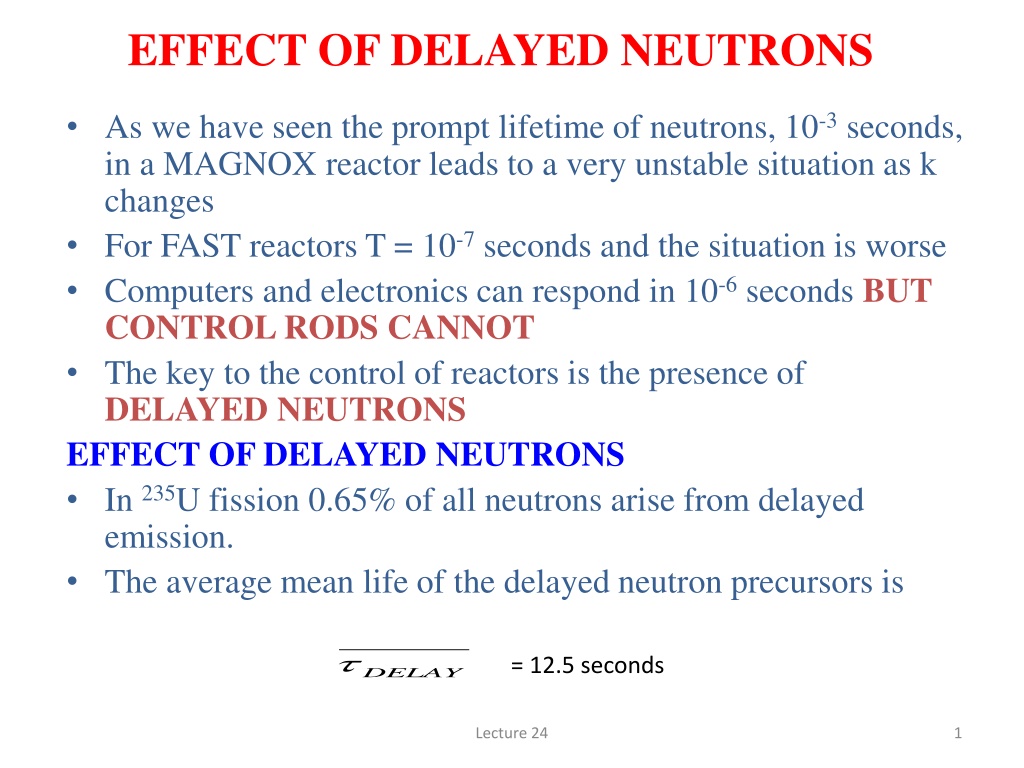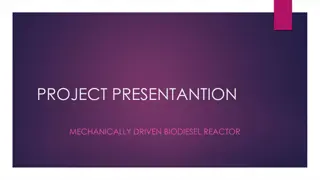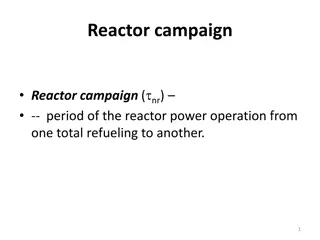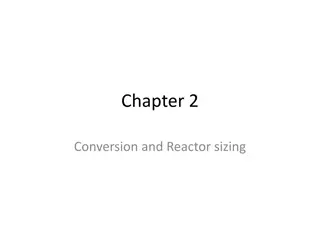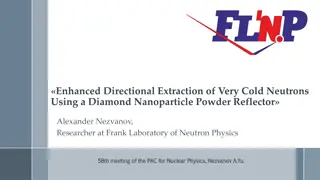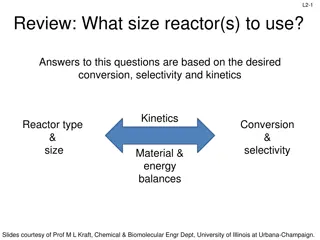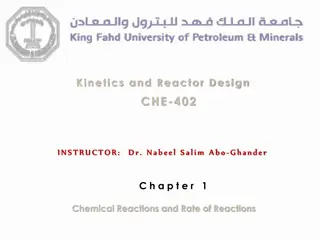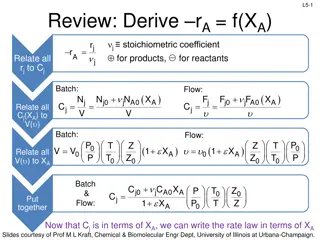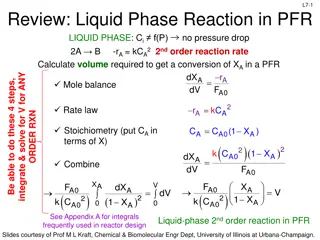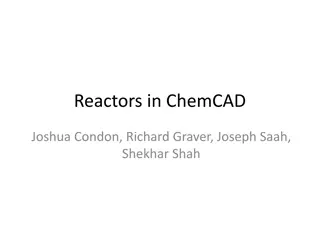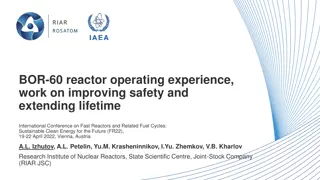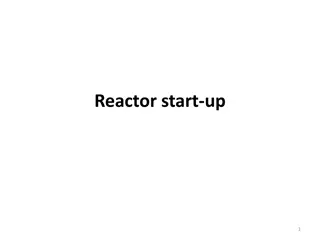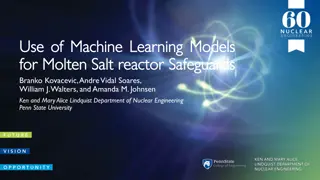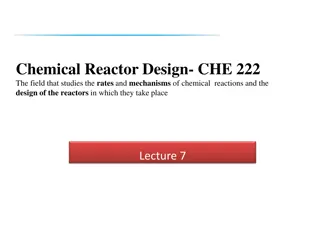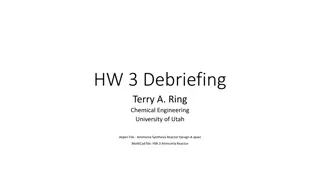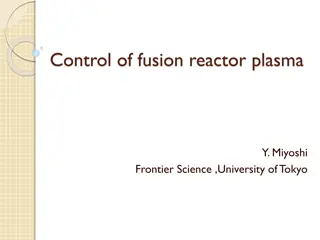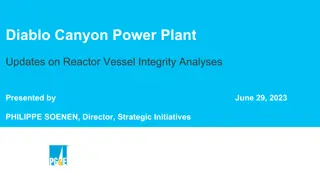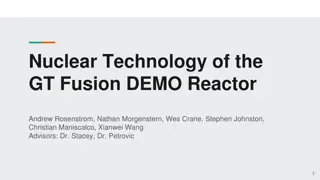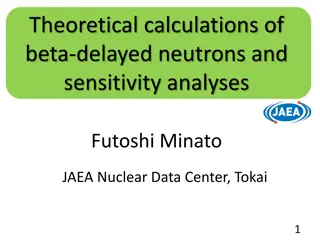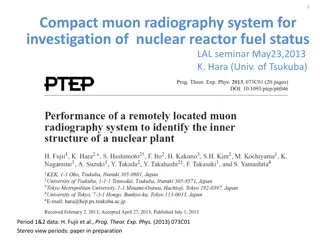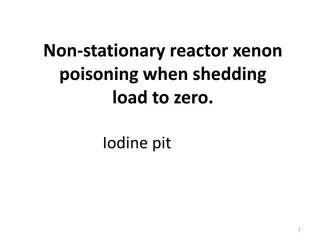Understanding the Role of Delayed Neutrons in Reactor Control
Delayed neutrons play a crucial role in controlling nuclear reactors by providing a means to adjust reactivity. These delayed neutrons, emanating from fission processes in 235U, have a longer mean lifetime compared to prompt neutrons. This characteristic allows for a more manageable reactor operation, enabling precise control over power output and safety measures. Additionally, factors such as fuel burn-up and reactor poisons impact reactor behavior, influencing the need for refueling and maintenance. By exploring the effects of delayed neutrons, reactor operators can enhance operational efficiency and safety protocols.
Download Presentation

Please find below an Image/Link to download the presentation.
The content on the website is provided AS IS for your information and personal use only. It may not be sold, licensed, or shared on other websites without obtaining consent from the author. Download presentation by click this link. If you encounter any issues during the download, it is possible that the publisher has removed the file from their server.
E N D
Presentation Transcript
EFFECT OF DELAYED NEUTRONS As we have seen the prompt lifetime of neutrons, 10-3seconds, in a MAGNOX reactor leads to a very unstable situation as k changes For FAST reactors T = 10-7seconds and the situation is worse Computers and electronics can respond in 10-6seconds BUT CONTROL RODS CANNOT The key to the control of reactors is the presence of DELAYED NEUTRONS EFFECT OF DELAYED NEUTRONS In 235U fission 0.65% of all neutrons arise from delayed emission. The average mean life of the delayed neutron precursors is DELAY = 12.5 seconds Lecture 24 1
The mean lifetime is (i.e. a weighted average) = + = 3 9935 . 0 10 . 0 0065 12 5 . . 0 08 s . 0 08 = 80 T s 3 10 k This is much more easily controllable This is a critical number and is studied with much more detailed calculations REACTIVITY CHANGES IN OPERATION 1. FUEL BURN UP (for thermal reactors) For a hypothetical pure 235U reactor the fuel concentration and hence k will reduce as the reactor burns fuel The fuel burn up is greatest at the centre where the neutron flux is highest Hence composition of the reactor varies non-uniformly and non-linearly with time For normal thermal reactors using natural or slightly enriched U NEW fissile material 239Pu is constantly produced by breeding reactions Lecture 24 2
The new 239Pu offsets the loss of 235U Extends useful life of fuel Produces more energy than is produced by 235U alone Important reactions in fuel burn up are n + 235U FISSION or 236U n + 238U 239U 239Np 239Pu n + 239Pu FISSION or 240Pu n + 240Pu 241Pu n + 241Pu FISSION or 242Pu high burn up The concentrations of 235U and 239Pu can be calculated i.e. dN 235 235 A = 241Pu fission is only important at the end of the fuel cycle at 235 ( U) ( U)N( U) dt dN = 238 238 238 ( U) ( U)N( U) A dt dN = + 239 239 239 238 238 ( Pu) ( Pu)N( Pu) ( U)N( U) A C dt Lecture 24 3
Integrating these equations we obtain = 235 235 235 N( U) N ( U)exp[ ( U).t] 0 A 238 ( U) = 239 238 239 C N( Pu) N ( U) {1 exp( ( Pu).t)} 0 A 239 ( Pu) A where N0 is the initial concentration The following graphs are examples for thermal ~ 1017 m-2 s-1 1.0 N N0 235U 0.5 239Pu 0 t (years) 1.0 2.0 3.0 SLIGHT INCREASE 0 k FALL OFF t (years) 1.0 2.0 3.0 Some refuelling is required before ~ 2 years Lecture 24 4
REACTOR POISONS Many fission products (i.e. different neutron rich isotopes) are produced in reactors Two products have huge capture cross sections for thermal neutrons and can effect reactor operations 1.13554Xe81 A=2.65 106 barns (cf A= 190barns for 133 Xe) Yield = 0.064 atoms per fission 2.14962Sm87 A=5.8 104 barns (cf A= 5.5barns for 154 Sm) Yield = 0.0113 atoms per fission They are formed primarily from decay 1.135Te 135I 135Xe 135Ce 135Ba 2.149Nd 149Pm 149Sm The 1/2 values increase along the chains -- 1/2 = 9.2 hrs for 135Xe and 149Sm is stable Lecture 24 5
135Xe is the main reactor poison and reaches a steady concentration after ~ 30 hours Causes k to decrease by 0.03 for ~1018 m-2 s-1 Need to build this amount of excess reactivity into the reactor During normal operation (> 30 hrs) 135Xe is being produced as above. Equilibrium comes through losses via 1. decay 2. The reaction 135Xe(n, ) 136Xe However after shutdown the (n, ) reaction ceases so 135Xe starts to build up from 135I decay until the 135Xe decay dominates This poisoning implies that it is not possible to re-start a reactor until 40-60 hrs after shutdown Need to build in excess k of 0.15 to cope with shutdown problems Lecture 24 6
EFFECT OF 135Xe ON REACTIVITY Consider a flux F ~ 1018 m-2 s-1 135Xe concentration -0.10 k due to 135Xe -0.05 STEADY STATE SHUTDOWN 0 hrs 2 0 4 0 6 0 START UP Excess reactivity of ~ 3% needed to overcome 135Xe during steady operation About 12% needed to enable the reactor to restart at any time In practice 15% is built in to allow for other poisons such as 149Sm 149Sm has a build up time ~ 53 hrs Lecture 24 7
EFFECT OF 149Sm ON REACTIVITY Consider a flux ~ 1018 m-2 s-1 149Sm concentration -0.02 k due to 149Sm -0.01 STEADY STATE SHUTDOWN 0 hrs 2 0 0 4 0 0 6 0 0 START UP In an operating reactor the quantity of 149Sm grows until production = destruction by neutron capture If the reactor is shut down more 149Sm is created since destruction stops i.e. no neutrons so no capture An excess reactivity of k~ 1.5% is needed to overcome this when starting the reactor Lecture 24 8
SHUTDOWN CHARACTERISITICS (Other than poisoning) 1. FISSION PRODUCT DECAY HEATING There is a large energy release from the fuel after shutdown due to radioactive decay of accumulated fission products Let F = fraction of power produced after shutdown F 10-1 10-2 Reactor operated for long time 10-3 For t~50days 10-4 DAYS AFTER SHUTDOWN 50 100 It is an important safety feature of power reactors that coolant circulates after shutdown to remove heat Lecture 24 9
2. DELAYED NEUTRONS The reduction of neutron flux to near zero at shutdown will be significantly delayed by this source of neutrons The neutron flux decays with a period equal to the mean life of the longest lived precursor (~ 80s) 0 1..0 0.5 20 40 Time (s) Lecture 24 10
ACCELERATOR DRIVEN SYSTEMS There are many advantages to be gained from accelerator driven systems A 1 GeV proton beam ~ 10mA current generates neutrons (spallation) in a heavy target e.g.Pb or U. inside a fast breeder assembly The coolant is metallic e.g. molten lead The fast fission unit uses 232Th as fuel running at k ~ 0.95 !! Each proton produces 13 fissions in the first generation, 13k in the 2nd, 13k2 in the 3rd etc giving a total of 13 / (1-k) fissions per proton. At 200 MeV per fission and k=0.95 this gives an energy gain of 50!! About 10-20% of this would be needed to power the accelerator Lecture 24 11
Example of an accelerator driven design The schematic shown is a conceptual design By C. Rubbia et al CERN/AT/95-44 (ET) Lecture 24 12
ADVANTAGES Operates far from the critical condition No conditions in which self sustaining reactions are possible Reactor stops when accelerator stops Breeds fuel and incinerates long lived wastes E.g. n + 232Th 233U chain May remove the need for geological storage of waste REQUIREMENTS Advance in cyclotron technology to deliver tens of milliamps at 1 GeV ~ 10 times current values but CERN are very confident it can be achieved An efficiency of 40 50% for converting electrical energy into beam energy Lecture 24 13
Outlook for Fission Reactors Economically nuclear power is compatible with fossil fuels in Europe but less so in the US due to differences in fuel costs Environmentally nuclear power is good for low CO2 emission but the main concerns are: 1. Risk of an accident then the siting of the reactor, population distribution, prevailing winds etc. etc. 2. Radioactive waste: high, intermediate and low level Stored on-site for several years in storage pools to remove heat and allow for the most intense activity to decay Then stored or reprocessed to recover U and Pu Remainder immobilised by vitrification into borosilicate glass, or incorporated in stable mineral lattices and stored in corrosion resistant cans in an underground depository Lecture 24 14
(2005) Nuclear Generation Number of Reactors Country % Total Electricity Operating Being Built Planned / Proposed France 79 59 0 2 Germany 31 17 0 0 Japan 29 55 1 12 Russia 16 31 4 9 UK 20 23 0 0 USA 19 103 1 13 World 16 441 27 153 Public opinion has a major effect on government decisions In a poll in europe in 2001 50% agreed to the nuclear power option if waste could be managed with 25% against The desire for a secure energy supply and a reduction of CO2 emissions is causing nations to re-evaluate the nuclear power option Lecture 24 15
